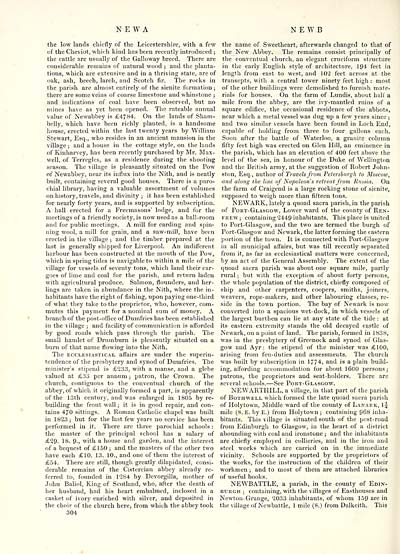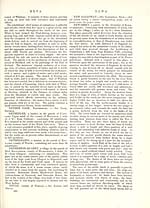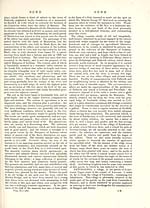Topographical dictionary of Scotland > Volume 2
(312) Page 304
Download files
Complete book:
Individual page:
Thumbnail gallery: Grid view | List view

NEWA
N E W B
the low lands chiefly of the Leicestershire, with a few
of the Cheviot, which kind has been recently introduced ;
the cattle are usually of the Galloway breed. There are
considerable remains of natural wood ; and the planta-
tions, which are extensive and in a thriving state, are of
oak, ash, beech, larch, and Scotch fir. The rocks in
the parish are almost entirely of the sienite formation ;
there are some veins of coarse limestone and whinstone ;
and indications of coal have been observed, but no
mines have as yet been opened. The rateable annual
value of Newabbey is £4784. On the lands of Sham-
belly, which have been richly planted, is a handsome
house, erected within the last twenty years by William
Stewart, Esq., who resides in an ancient mansion in the
village ; and a house in the cottage style, on the lands
of Kinharvey, has been recently purchased by Mr. Max-
well, of Terregles, as a residence during the shooting
season. The village is pleasantly situated on the Pow
of Newabbey, near its influx into the Nith, and is neatly
built, containing several good houses. There is a paro-
chial library, having a valuable assortment of volumes
on history, travels, and divinity ; it has been established
for nearly forty years, and is supported by subscription.
A hall erected for a Freemasons' lodge, and for the
meetings of a friendly society, is now used as a ball-room
and for public meetings. A mill for carding and spin-
ning wool, a mill for grain, and a saw-mil), have been
erected in the village ; and the timber prepared at the
last is generally shipped for Liverpool. An indifferent
harbour has been constructed at the mouth of the Pow,
which in spring tides is navigable to within a mile of the
village for vessels of seventy tons, which land their car-
goes of lime and coal for the parish, and return laden
with agricultural produce. Salmon, flounders, and her-
lings are taken in abundance in the Nith, where the in-
habitants have the right of fishing, upon paying one-third
of what they take to the proprietor, who, however, com-
mutes this payment for a nominal sum of money. A
branch of the post-office of Dumfries has been established
in the village ; and facility of communication is afforded
by good roads which pass through the parish. The
small hamlet of Drumburn is pleasantly situated on a
burn of that name flowing into the Nith.
The ecclesiastical affairs are under the superin-
tendence of the presbytery and synod of Dumfries. The
minister's stipend is £233, with a manse, and a glebe
valued at £33 per annum ; patron, the Crown. The
church, contiguous to the conventual church of the
abbey, of which it originally formed a part, is apparently
of the 13th century, and was enlarged in 1805 by re-
building the front wall ; it is in good repair, and con-
tains 470 sittings. A Roman Catholic chapel was built
in 1823 ; but for the last few years no service has been
performed in it. There are three parochial schools :
the master of the principal school has a salary of
£29. 18. 9., with a house and garden, and the interest
of a bequest of £150 ; and the masters of the other two
have each £10. 13. 10., and one of them the interest of
£54. There are still, though greatly dilapidated, consi-
derable remains of the Cistercian abbey already re-
ferred to, founded in 12S4 by Devorgilla, mother of
John Baliol, King of Scotland, who, after the death of
her husband, had his heart embalmed, inclosed in a
casket of ivory enriched with silver, and deposited in
the choir of the church here, from which the abbey took
304
the name of Sweetheart, afterwards changed to that of
the New Abbey. The remains consist principally of
the conventual church, an elegant cruciform structure
in the early English style of architecture, 194 feet in
length from east to west, and 102 feet across at the
transepts, with a central tower ninety feet high : most
of the other buildings were demolished to furnish mate-
rials for houses. On the farm of Lundis, about half a
mile from the abbey, are the ivy-mantled ruins of a
square edifice, the occasional residence of the abbots,
near which a metal vessel was dug up a few years since ;
and two similar vessels have been found in Loch End,
capable of holding from three to four gallons each.
Soon after the battle of Waterloo, a granite column
fifty feet high was erected on Glen Hill, an eminence in
the parish, which has an elevation of 400 feet above the
level of the sea, in honour of the Duke of Wellington
and the British army, at the suggestion of Robert John-
ston, Esq., author of Travels from Petersburgh to Moscow,
and along the line of Napoleon s retreat from Russia. On
the farm of Craigend is a large rocking stone of sienite,
supposed to weigh more than fifteen tons.
NEWARK, lately a quoad sacra parish, in the parish
of Port-Glasgow, Lower ward of the county of Ren-
frew; containing 2449 inhabitants. This place is united
to Port-Glasgow, and the two are termed the burgh of
Port-Glasgow and Newark, the latter forming the eastern
portion of the town. It is connected with Port-Glasgow
in all municipal affairs, but was till recently separated
from it, as far as ecclesiastical matters were concerned,
by an act of the General Assembly. The extent of the
quoad sacra parish was about one square mile, partly
rural ; but with the exception of about forty persons,
the whole population of the district, chiefly composed of
ship and other carpenters, coopers, smiths, joiners,
weavers, rope-makers, and other labouring classes, re-
side in the town portion. The bay of Newark is now
converted into a spacious wet-dock, in which vessels of
the largest burthen can lie at. any state of the tide : at
its eastern extremity stands the old decayed castle of
Newark, on a point of land. The parish, formed in 183S,
was in the presbytery of Greenock and synod of Glas-
gow and Ayr: the stipend of the minister was £100,
arising from feu-duties and assessments. The church
was built by subscription in 1774, and is a plain build-
ing, affording accommodation for about 1600 persons;
patrons, the proprietors and seat-holders. There are
several schools. — See Port-Glasgow.
NEWARTHILL, a village, in that part of the parish
of Bothwell which formed the late quoad sacra parish
of Holytown, Middle ward of the county of Lanark, l£
mile (S. E. by E.) from Holytown ; containing 968 inha-
bitants. This village is situated south of the post-road
from Edinburgh to Glasgow, in the heart of a district
abounding with coal and ironstone ; and the inhabitants
are chiefly employed in collieries, and in the iron and
steel works which are carried on in the immediate
vicinity. Schools are supported by the proprietors of
the works, for the instruction of the children of their
workmen ; and to most of them are attached libraries
of useful books.
NEWBATTLE, a parish, in the county of Edin-
burgh ; containing, with the villages of Easthouses and
Newton-Grange, 2033 inhabitants, of whom 159 are in
the village of Newbattle, 1 mile (S.) from Dalkeith. This
N E W B
the low lands chiefly of the Leicestershire, with a few
of the Cheviot, which kind has been recently introduced ;
the cattle are usually of the Galloway breed. There are
considerable remains of natural wood ; and the planta-
tions, which are extensive and in a thriving state, are of
oak, ash, beech, larch, and Scotch fir. The rocks in
the parish are almost entirely of the sienite formation ;
there are some veins of coarse limestone and whinstone ;
and indications of coal have been observed, but no
mines have as yet been opened. The rateable annual
value of Newabbey is £4784. On the lands of Sham-
belly, which have been richly planted, is a handsome
house, erected within the last twenty years by William
Stewart, Esq., who resides in an ancient mansion in the
village ; and a house in the cottage style, on the lands
of Kinharvey, has been recently purchased by Mr. Max-
well, of Terregles, as a residence during the shooting
season. The village is pleasantly situated on the Pow
of Newabbey, near its influx into the Nith, and is neatly
built, containing several good houses. There is a paro-
chial library, having a valuable assortment of volumes
on history, travels, and divinity ; it has been established
for nearly forty years, and is supported by subscription.
A hall erected for a Freemasons' lodge, and for the
meetings of a friendly society, is now used as a ball-room
and for public meetings. A mill for carding and spin-
ning wool, a mill for grain, and a saw-mil), have been
erected in the village ; and the timber prepared at the
last is generally shipped for Liverpool. An indifferent
harbour has been constructed at the mouth of the Pow,
which in spring tides is navigable to within a mile of the
village for vessels of seventy tons, which land their car-
goes of lime and coal for the parish, and return laden
with agricultural produce. Salmon, flounders, and her-
lings are taken in abundance in the Nith, where the in-
habitants have the right of fishing, upon paying one-third
of what they take to the proprietor, who, however, com-
mutes this payment for a nominal sum of money. A
branch of the post-office of Dumfries has been established
in the village ; and facility of communication is afforded
by good roads which pass through the parish. The
small hamlet of Drumburn is pleasantly situated on a
burn of that name flowing into the Nith.
The ecclesiastical affairs are under the superin-
tendence of the presbytery and synod of Dumfries. The
minister's stipend is £233, with a manse, and a glebe
valued at £33 per annum ; patron, the Crown. The
church, contiguous to the conventual church of the
abbey, of which it originally formed a part, is apparently
of the 13th century, and was enlarged in 1805 by re-
building the front wall ; it is in good repair, and con-
tains 470 sittings. A Roman Catholic chapel was built
in 1823 ; but for the last few years no service has been
performed in it. There are three parochial schools :
the master of the principal school has a salary of
£29. 18. 9., with a house and garden, and the interest
of a bequest of £150 ; and the masters of the other two
have each £10. 13. 10., and one of them the interest of
£54. There are still, though greatly dilapidated, consi-
derable remains of the Cistercian abbey already re-
ferred to, founded in 12S4 by Devorgilla, mother of
John Baliol, King of Scotland, who, after the death of
her husband, had his heart embalmed, inclosed in a
casket of ivory enriched with silver, and deposited in
the choir of the church here, from which the abbey took
304
the name of Sweetheart, afterwards changed to that of
the New Abbey. The remains consist principally of
the conventual church, an elegant cruciform structure
in the early English style of architecture, 194 feet in
length from east to west, and 102 feet across at the
transepts, with a central tower ninety feet high : most
of the other buildings were demolished to furnish mate-
rials for houses. On the farm of Lundis, about half a
mile from the abbey, are the ivy-mantled ruins of a
square edifice, the occasional residence of the abbots,
near which a metal vessel was dug up a few years since ;
and two similar vessels have been found in Loch End,
capable of holding from three to four gallons each.
Soon after the battle of Waterloo, a granite column
fifty feet high was erected on Glen Hill, an eminence in
the parish, which has an elevation of 400 feet above the
level of the sea, in honour of the Duke of Wellington
and the British army, at the suggestion of Robert John-
ston, Esq., author of Travels from Petersburgh to Moscow,
and along the line of Napoleon s retreat from Russia. On
the farm of Craigend is a large rocking stone of sienite,
supposed to weigh more than fifteen tons.
NEWARK, lately a quoad sacra parish, in the parish
of Port-Glasgow, Lower ward of the county of Ren-
frew; containing 2449 inhabitants. This place is united
to Port-Glasgow, and the two are termed the burgh of
Port-Glasgow and Newark, the latter forming the eastern
portion of the town. It is connected with Port-Glasgow
in all municipal affairs, but was till recently separated
from it, as far as ecclesiastical matters were concerned,
by an act of the General Assembly. The extent of the
quoad sacra parish was about one square mile, partly
rural ; but with the exception of about forty persons,
the whole population of the district, chiefly composed of
ship and other carpenters, coopers, smiths, joiners,
weavers, rope-makers, and other labouring classes, re-
side in the town portion. The bay of Newark is now
converted into a spacious wet-dock, in which vessels of
the largest burthen can lie at. any state of the tide : at
its eastern extremity stands the old decayed castle of
Newark, on a point of land. The parish, formed in 183S,
was in the presbytery of Greenock and synod of Glas-
gow and Ayr: the stipend of the minister was £100,
arising from feu-duties and assessments. The church
was built by subscription in 1774, and is a plain build-
ing, affording accommodation for about 1600 persons;
patrons, the proprietors and seat-holders. There are
several schools. — See Port-Glasgow.
NEWARTHILL, a village, in that part of the parish
of Bothwell which formed the late quoad sacra parish
of Holytown, Middle ward of the county of Lanark, l£
mile (S. E. by E.) from Holytown ; containing 968 inha-
bitants. This village is situated south of the post-road
from Edinburgh to Glasgow, in the heart of a district
abounding with coal and ironstone ; and the inhabitants
are chiefly employed in collieries, and in the iron and
steel works which are carried on in the immediate
vicinity. Schools are supported by the proprietors of
the works, for the instruction of the children of their
workmen ; and to most of them are attached libraries
of useful books.
NEWBATTLE, a parish, in the county of Edin-
burgh ; containing, with the villages of Easthouses and
Newton-Grange, 2033 inhabitants, of whom 159 are in
the village of Newbattle, 1 mile (S.) from Dalkeith. This
Set display mode to: Large image | Transcription
Images and transcriptions on this page, including medium image downloads, may be used under the Creative Commons Attribution 4.0 International Licence unless otherwise stated. ![]()
| Gazetteers of Scotland, 1803-1901 > Topographical dictionary of Scotland > Volume 2 > (312) Page 304 |
|---|
| Permanent URL | https://digital.nls.uk/97364874 |
|---|
| Description | Volume II: From Keanlochbervie to Zetland. |
|---|---|
| Attribution and copyright: |
|

